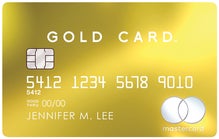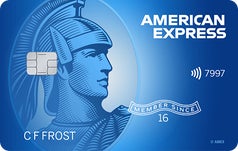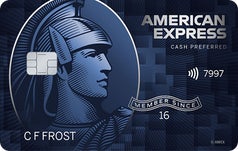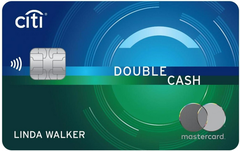Mastercard® Gold Card™ review: An overpriced status symbol
If it’s status you’re after, this gold-plated card might be worth it but only if you can afford the annual fee.
The Bankrate promise
At Bankrate we strive to help you make smarter financial decisions. While we adhere to strict , this post may contain references to products from our partners. Here's an explanation for .
Snapshot
2.9
Bottom line
This card offers impressive perks that help it live up to its reputation as a status symbol. But when it comes to overall value, other cards exceed the Mastercard Gold card in many areas with a smaller annual fee.
Intro offer
N/A
Rewards rate
1 point
Annual fee
$995 ($295 for each Authorized User added to the account)
Regular APR
20.24% to 28.24% Variable APR on purchases and balance transfers, based on your creditworthiness and other factors
4.2
Cardholder rating
Extra perks
Meets needs
Online tools
Customer service
2.9
Bankrate score
Rewards value
APR
Rewards flexibility
Features
Remove a card to add another to compare
Remove a card to add another to compare
Mastercard Gold Card overview
Many exclusive benefits of luxury credit cards are reserved for ultrawealthy cardholders. Unless you meet many issuers’ mystery requirements and receive an invitation, these cards can be closed off to you even if you have excellent credit.
The Mastercard® Gold Card™ provides an opportunity to snag one of these “status symbol” elite cards. The Mastercard Gold is the top-of-the-line luxury card offered by Barclays. But is this card worth the massive $995 annual fee, or is it just a way to flash your status? Read on to see if the Mastercard Gold is worth its literal weight in gold compared to other premium travel credit cards.
-
Rewards
- 1X points on all purchases
Expert Appraisal: Unimpressive
See our expert analysis -
0% intro APR offer
- 0 percent intro APR for 15 billing cycles on balance transfers made within 45 days of account opening
- After that, variable APR of 20.24% to 28.24% Variable APR on purchases and balance transfers, based on your creditworthiness and other factors
Expert Appraisal: Unimpressive
See our expert analysis -
Rates and fees
- Annual fee: $995
- Balance transfer fee: Either $5 or 5 percent of the amount of each transfer, whichever is greater
- Cash advance fee: Either $10 or 5 percent of the amount of each transfer, whichever is greater
- Foreign transaction fee: $0
- Late/returned payment fee: up to $40
Expert Appraisal: Unimpressive
See our expert analysis -
Other cardholder perks
- Up to $120 automatic statement credit for Global Entry or TSA Precheck® application fees
- Up to $200 in annual air travel credit toward flight-related purchases including airline tickets, baggage fees, upgrades and more
- Priority Pass Select airport lounge access
- Luxury Card Travel program offers up to $500 in benefits and services at more than 3,000 properties.
- Cellphone protection
- Travel protections: Trip cancellation or interruption insurance, baggage delay insurance, travel accident insurance and auto rental collision waiver coverage
Expert Appraisal: Good
See our expert analysis
Mastercard Gold Card pros and cons
Pros
-
This card has a comprehensive set of luxury travel benefits.
-
You’ll get a decent intro APR offer on balance transfers if you need to consolidate debt.
-
You can redeem unlimited points for 2 cents-per-point value on airfare and cash back redemptions.
Cons
-
The value of this card doesn’t match that of other high-end luxury premium cards.
-
You can get equal or better earning rates on cards with no annual fee.
-
This card has one of the highest annual fees on the market.
Why you might want the Mastercard Gold Card
The Mastercard Gold is a luxury status symbol. You’ll want it if you prefer luxury benefits while traveling, as its perks are one of its main selling points.
Perks: Luxurious features to travel in style
The Mastercard Gold’s portfolio of benefits offers much more value than the card’s rewards program if you take advantage of the travel perks. While it still doesn’t measure up to other premium travel cards, especially considering the much higher annual fee, the benefits are the card's main selling point.
The Mastercard Gold’s offerings are geared toward providing luxury while traveling. You can improve your airport experience with credit towards either Global Entry or TSA Precheck, Priority Pass lounge access and an annual airfare credit that is easy to use and covers a wide range of expenses.
The luxury perks don’t end once you arrive at your destination. You’ll have 24/7 access to concierge services that can help secure high-demand reservations or events, arrange various services or make recommendations about how to enjoy your experience to the fullest. If you book through the Luxury Card Travel program, you can get additional value with room upgrades, daily breakfast for two, late checkout and other unique property amenities. You can also access Mastercard Priceless experiences, such as Priceless Golf, which gives you access to over 1,000 private country clubs in North America.
The Mastercard Gold comes with an excellent set of travel protections, which include trip cancellation and interruption, baggage delay and travel accident insurance, car rental collision insurance and other travel assistance services. You’ll also have cellphone protection for damage or theft. The coverage amounts on this card are on par with other top-of-the-line travel cards. While you hope never to use these benefits, they can save a trip when issues arise.
You’ll also get some of the best standard Mastercard benefits. Mastercard offers solid ID theft and fraud protection, as well as the usual World Elite offerings, which include:
- Complimentary ShopRunner membership
- $5 monthly Lyft credit after taking three rides in a month
- Two complimentary months of Instacart+ and $10 off your second order each month
- $3 monthly statement credit for Peacock or $5 monthly statement credit for Peacock Premium Plus
Status symbol: Look like a heavy hitter
If you like making a flashy display, this card is for you. It’s the living picture of a status symbol — a 24K gold-plated stainless steel credit card that weighs in at a hefty 22g (four more grams than other premium cards like The Platinum Card® from American Express). If you think the sound and appearance of dropping one of the best metal cards is awe-inspiring, imagine how much more of a show dropping this card will make.
While the Mastercard Gold Card isn’t as rewarding or challenging to attain as legendary cards like the American Express Centurion Card or as glamorous as the diamond-encrusted and palladium-lined credit cards for the uber-wealthy, it should suffice if you’re looking to make a splash.
Why you might want a different premium travel card
Many credit cards beat the Mastercard Gold card for various reasons, whether earning better rewards, charging lower fees or offering a welcome bonus. Consider brand-specific travel cards like hotel credit cards or cards for your favorite airlines that may earn more and better serve your specific travel needs.
Rewards: Weak earnings and limited redemptions
Though the Gold Card touts a better redemption rate than the Chase Sapphire Reserve® card’s 50 percent redemption boost for travel booked through Chase Travel℠, its rewards are less flexible and valuable overall.
You earn unlimited 1X points on all purchases. This is relatively low, considering you can earn more with no-annual-fee cards. 100 Mastercard Gold Card points equal $1 when you redeem for a car rental or hotel stay, for a value of 1 cent. But when redeeming for airfare or cash back, your points are worth 2 cents each. All travel must be reserved through InComm InCentives on myluxurycard.com (or by calling the customer service number on the back of your card). There aren’t any transfer partners or any other way to get extra value from your points, which is quite a limiting factor.
Your point value also may vary depending if you redeem for gift cards or merchandise. Note that you’ll lose any points earned that month if you fail to make a minimum payment online.
In contrast, rewards programs like Chase’s offer additional point value with various transfer travel partners. Based on Bankrate’s valuations, Chase Ultimate Rewards points can reach a market value of 2 cents per point because of excellent transfer partner deals. By comparison, Mastercard Gold Card travel experience opportunities are restricted to select experiences that may rotate, and there are only 3,000-plus properties, which falls short of Chase’s offerings by a wide margin.
Rates and fees: Extremely high annual fees
Since the Mastercard Gold’s point values are slightly below Amex Membership Rewards and Chase Ultimate Rewards, the most significant sticking point is the extremely high $995 annual fee. You’d need to spend a whopping $4,146 monthly — or $49,750 per year — and always redeem at the 2 percent value just to break even. If you’re considering adding an authorized user to help earn more rewards, that's another $295 annual fee per user. These are some of the highest overall fees on the market. Other premium travel cards have much lower annual fees and meet or exceed the overall value of the Mastercard Gold card.
The other rates and fees are standard if the high membership cost doesn’t dissuade you. Like any decent travel card, there are no foreign transaction fees. And you’ll get some help if you need to pay off another card with a respectable 0 percent intro APR for 15 billing cycles on balance transfers made within the first 45 days (20.24% to 28.24% Variable APR on purchases and balance transfers, based on your creditworthiness and other factors variable APR after that, with a balance transfer fee of 5 percent or $5, whichever is greater). There isn’t a similar purchase offer, but the ongoing APR is comparable with the current average interest rate.
Welcome offer: No additional value other than debt consolidation
The Mastercard Gold Card doesn’t offer a sign-up bonus in the form of points or an intro APR on purchases, which doesn’t make the staggering price tag any easier. While the intro APR on balance transfers is decent, it seems out of character for this card. Debt consolidation likely wouldn’t be a priority if you are considering this card.
A welcome offer would add significant value to this card, especially given the mediocre rewards earning rates. Other premium travel cards offer generous welcome offers to entice applicants by providing a straightforward way to offset the annual fee in the first year.
How the Mastercard Gold Card compares to other premium travel cards
The Mastercard Gold Card’s value is measured primarily by its entry cost. The rewards rates are mediocre at best, so the deciding factor with this card will be how you utilize its travel benefits. Other options might provide more rewards and benefits if you're considering more attainable cards.

Annual fee
Intro offer
Rewards rate
1 point for every $1 spent on all purchases (2% value for Airfare Redemptions & Cash Back Redemptions).
Recommended Credit Score
A FICO score/credit score is used to represent the creditworthiness of a person and may be one indicator to the credit type you are eligible for. However, credit score alone does not guarantee or imply approval for any financial product.

Annual fee
Intro offer
Earn 60,000 bonus points after you spend $4,000 on purchases in the first 3 months from account opening.
Rewards rate
Earn 10x total points on hotels and car rentals when you purchase travel through Chase Travel℠. Earn 5x total points on flights through Chase Travel℠. Earn 3x points on other travel and dining. Earn 1 point per $1 spent on all other purchases.
Recommended Credit Score
A FICO score/credit score is used to represent the creditworthiness of a person and may be one indicator to the credit type you are eligible for. However, credit score alone does not guarantee or imply approval for any financial product.

Annual fee
Intro offer
Earn 80,000 Membership Rewards® Points after you spend $8,000 on eligible purchases on your new Card in your first 6 months of Card Membership.
Rewards rate
Earn 5X Membership Rewards® Points for flights booked directly with airlines or with American Express Travel up to $500,000 on these purchases per calendar year. Earn 5X Membership Rewards® Points on prepaid hotels booked with American Express Travel.
Recommended Credit Score
A FICO score/credit score is used to represent the creditworthiness of a person and may be one indicator to the credit type you are eligible for. However, credit score alone does not guarantee or imply approval for any financial product.
Who is the Mastercard Gold Card right for?
The Mastercard Gold card is intended for people seeking a luxury travel experience or seeking a certain level of status with this card.
Bankrate’s Take — Is the Mastercard Gold Card worth it?
If you want to experience the world of luxury travel but rewards and money-saving perks are still a priority, then it might be hard to justify the Mastercard Gold Card’s $995 annual fee.
But if you’re in the market for a card that will let you feel like a member of the rich and famous, the Mastercard Gold could suit you until you get an exclusive invitation to a more impressive luxury card.
How we rated this card
We rate credit cards using a proprietary card scoring system that ranks each card’s estimated average rewards rate, estimated annual earnings, welcome bonus value, APR, fees, perks and more against those of other cards in its primary category.
Each card feature is assigned a weighting based on how important it is to people looking for a card in a given category. These features are then scored based on how they rank relative to the features on other cards in the category. Based on these calculations, each card receives an overall rating of 1-5 stars (with 5 being the highest possible score and 1 being the lowest).
We analyzed over 150 of the most popular rewards and cash back cards to determine where each stacked up based on their value, cost, benefits and more. Here are some of the key factors that influenced this card’s overall score and how the score influenced our review:
Frequently asked questions
What cardholders think
In May 2024, Bankrate collaborated with third-party SliceMR to survey 6160 cardholders nationwide. Bankrate and Slice MR collected, averaged and presented website analytics and cardholder responses to six questions on a 5-point scale. Responses are based on individual cardholder’s product details, and therefore cannot be verified for accuracy. Users received an incentive for their feedback. User ratings are unedited and have not been reviewed or approved by credit card issuers, nor do these ratings reflect Bankrate’s own reviews of these cards.
Community Reviews
* See the online application for details about terms and conditions for these offers. Every reasonable effort has been made to maintain accurate information. However all credit card information is presented without warranty. After you click on the offer you desire you will be directed to the credit card issuer's web site where you can review the terms and conditions for your selected offer.
Editorial Disclosure: Opinions expressed here are the author's alone, and have not been reviewed or approved by any advertiser. The information, including card rates and fees, is accurate as of the publish date. All products or services are presented without warranty. Check the bank’s website for the most current information.











